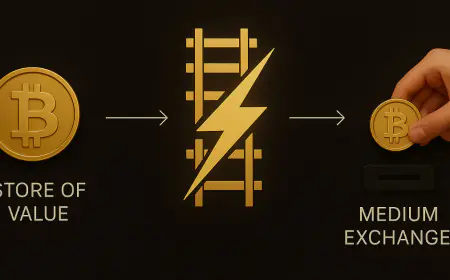CryptoNight Mining Algorithm: How Does it Work for Crypto Miners?
Cryptocurrency mining algorithms are fundamental components of blockchain networks that validate transactions and secure these decentralized systems. These algorithms define the rules by which miners, individuals, or entities participating in the network compete to solve complex computational puzzles or mathematical problems specific to each algorithm. Successfully solving these puzzles allows miners to add new blocks […]

Cryptocurrency mining algorithms are fundamental components of blockchain networks that validate transactions and secure these decentralized systems. These algorithms define the rules by which miners, individuals, or entities participating in the network compete to solve complex computational puzzles or mathematical problems specific to each algorithm. Successfully solving these puzzles allows miners to add new blocks of transactions to the blockchain and earn rewards from newly created cryptocurrency tokens.
The significance of mining algorithms lies in several key aspects. First, they ensure the integrity and security of the blockchain by making it computationally expensive and highly impractical for malicious actors to tamper with transaction history. This cryptographic security is paramount in maintaining trust within the network.
Moreover, mining algorithms contribute to decentralization, a core principle of many cryptocurrencies. Some algorithms, like CryptoNight, are designed to resist centralization by requiring significant memory resources and discouraging the use of specialized mining hardware known as ASICs. This promotes a more distributed and accessible mining ecosystem.
Additionally, the diversity of mining algorithms allows miners to choose the cryptocurrency they want to mine based on their hardware capabilities and preferences. Whether prioritizing processing power or memory, miners can select the most suitable cryptocurrency, fostering competition and innovation within the mining community.
Mining algorithms serve as the backbone of cryptocurrency networks, defining the rules for transaction validation, enhancing security, promoting decentralization, and offering a range of options for miners to participate in the blockchain ecosystem. Understanding these algorithms is essential for anyone involved in cryptocurrency mining activities.
The CryptoNight algorithm
The CryptoNight algorithm is a mining algorithm that plays a crucial role in the world of cryptocurrencies. It’s part of the CryptoNote consensus protocol used by various cryptocurrencies.
CryptoNight is designed for Proof of Work (PoW) mining, and it’s unique because it’s optimized for both CPU and GPU mining, which means you can mine using regular computer hardware. One of its main goals is to resist ASIC mining, which is when specialized hardware is used for mining, as this can lead to the centralization of mining power.
To achieve this resistance, CryptoNight combines different hashing functions, including CryptoNight and Keccak, making it challenging for ASICs to gain an advantage. It’s also known for its strong focus on security, using the Advanced Encryption Standard (AES), a military-level security algorithm.
Interestingly, CryptoNight’s creator is a mysterious figure known as Nicolas van Saberhagen, similar to how Bitcoin’s creator, Satoshi Nakamoto, remains anonymous. This has led to speculation that they might be the same person. CryptoNote, which CryptoNight is a part of, was introduced on December 12, 2012, and it aimed to enhance privacy and security in cryptocurrency transactions through features like confidential transactions and ring signatures.
The CryptoNight algorithm is a key element in cryptocurrency mining, known for its accessibility, resistance to ASICs, and a strong focus on security. Its creator’s anonymity adds a touch of intrigue to its history, much like the early days of Bitcoin.
Why is CryptoNight Important?
It holds significance for several important reasons. It was specifically designed to level the playing field for miners, allowing both CPUs and GPUs to mine effectively while discouraging the use of specialized ASIC mining rigs.
One key aspect is privacy. Unlike many cryptocurrencies, such as Bitcoin, where transactions are transparent and traceable through public addresses, it prioritizes user privacy. It incorporates advanced privacy features like ring signatures and stealth addresses, developed by the Monero team, to enhance security and anonymity for those who value private blockchain transactions.
Furthermore, it addresses the concern of centralization in cryptocurrency mining. It strives to challenge the dominance of ASIC mining rigs, which can concentrate mining power in the hands of a few. By promoting a competitive environment where GPUs and CPUs can remain effective miners, CryptoNight aims to maintain a decentralized mining ecosystem.
Scalability and efficiency are also the core principles. Its computational requirements increase significantly, ensuring faster transaction processing and improved scalability, which are vital for a cryptocurrency’s growth and adoption.
CryptoNight’s Working Principles
It operates on the principles of fairness, privacy, and scalability. At its core, it is a mining algorithm designed to provide equal opportunities for both CPUs (Central Processing Units) and GPUs (Graphics Processing Units) to participate in the mining process while discouraging the use of specialized mining hardware known as ASICs (Application-Specific Integrated Circuits).
Privacy Enhancement
One of its key features is its commitment to user privacy. Unlike some cryptocurrencies where transactions are transparent and easily traceable through public addresses, CryptoNight prioritizes privacy. It achieves this through advanced privacy tools integrated into the algorithm, including ring signatures and stealth addresses, developed by the Monero team.
These features ensure that transactions remain untraceable, enhancing security and anonymity for users who value private blockchain transactions.
Resisting Centralization
Another critical aspect is its effort to combat centralization in cryptocurrency mining. The algorithm addresses the concern that ASIC mining rigs, which are specialized hardware, can concentrate mining power in the hands of a few entities. To counter this, CryptoNight aims to create a competitive environment where GPUs and CPUs can effectively mine, preserving the decentralization of the mining ecosystem.
This approach promotes a fairer mining power distribution and ensures that cryptocurrencies remain accessible to more individuals.
Scalability and Efficiency
CryptoNight also places a strong emphasis on scalability and efficiency. It achieves greater scalability through increased computational requirements, allowing faster transaction processing. This scalability is essential for the growth and adoption of a cryptocurrency, ensuring that it can handle a larger volume of transactions efficiently.
Prominent Cryptocurrencies Using CryptoNight Algorithm
Let’s look at five notable cryptocurrencies that employ the CryptoNight hashing algorithm and their stances on ASIC resistance. There are variations of CryptoNight algorithms like CryptoNight Lite and CryptoNight Heavy.
Bytecoin (BCN)
Bytecoin was the first cryptocurrency to utilize the CryptoNight algorithm. Initially, it aimed for ASIC resistance, but later, Bytecoin changed its position. In 2018, they announced their support for ASIC mining, preserving the original CryptoNight algorithm. Bytecoin’s decision was driven by concerns about security and anonymity risks, as they believed ASIC miners contributed to the network’s defense capabilities.
While Bytecoin is exploring GPU support, they advise miners to consider ASIC rigs, acknowledging that banning ASICs might be ineffective due to upcoming FPGA devices adaptable to algorithm changes.
Electroneum (ETN)
Electroneum’s stance on ASIC resistance needs to be more consistent. In 2018, they switched from the original CryptoNight to CryptoNight v7 due to the influence of GPU miners. However, after facing network vulnerabilities and decreased profitability, they reverted to the original CryptoNight algorithm in mid-2018, sparking community debates.
HYCON (HYC)
HYCON employs the CryptoNight v7 algorithm and initially considered implementing the Blake2b hash function. However, they chose CryptoNight for its higher ASIC resistance, as stated in an updated whitepaper from May 2019. The project also mentioned periodic algorithm changes as a deterrent to ASICs, providing HYCON-specific mining rigs for CPUs, Nvidia GPUs, and AMD GPUs on their GitHub.
Dero (DERO)
Dero aligns with the original CryptoNight algorithm and appears to support ASIC miners. Despite considering modifying their algorithm in response to Monero’s RandomX, they decided to stick with CryptoNight due to concerns about security issues during testing and dependencies on chip manufacturers. These concerns led Dero to maintain CryptoNight for the foreseeable future.
These cryptocurrencies employ the CryptoNight algorithm with varying approaches to ASIC resistance, reflecting the ongoing debate within the crypto community about the role of ASICs in mining.
CryptoNight’s Stance on Resisting ASICs
One of the fundamental reasons behind the creation of the algorithm was to address the growing threat posed by ASIC mining rigs, which had the potential to centralize the mining of cryptocurrencies.
Even though the first commercial ASIC mining rigs didn’t appear until 2013, well after CryptoNight’s inception, the developers anticipated a future where ASICs could dominate the mining landscape. They aimed to establish a mining system where GPUs and CPUs could remain competitive.
Unlike Bitcoin’s SHA-256 hashing algorithm, which requires less computational memory, it was intentionally designed to be memory-intensive. This memory-intensive approach aimed to thwart ASICs more effectively than other algorithms like Scrypt, which attempted to resist ASIC dominance but didn’t achieve the same level of ASIC resistance that CryptoNight sought to establish.
CryptoNight’s Effectiveness in Resisting ASICs
CryptoNight, despite its initial intentions, has faced challenges in robustly resisting ASICs. While it initially outperformed other algorithms like SHA-256, ASIC dominance became apparent in early 2018.
Struggles Against ASICs
A prominent example of these challenges can be seen in Monero, a key player in the ecosystem. Monero recognized that regular hard forks could decentralize mining and introduced a higher dependence on developers. This approach sometimes resulted in unintended consequences, including creating new forked coins and reduced support for the core project.
Additionally, ASIC producers demonstrated remarkable adaptability to algorithm tweaks, often adjusting their hardware within a short timeframe, leading to a swift return on their investments.
CryptoNight projects often found themselves balancing priorities like private transactions, network security, and ASIC resistance. In many cases, the focus shifted toward the first two objectives. Achieving all three objectives might require a more fundamental approach, such as a complete algorithm change.
The Challenges of the CryptoNight Algorithm
The CryptoNight protocol, while offering some advantages, comes with its share of downsides that need consideration:
Memory-Hardness: CryptoNight’s memory-hardness is a double-edged sword. On one hand, it’s designed to deter the development of specialized mining hardware, promoting fairness. On the other hand, this feature demands a significant amount of memory, increasing mining costs.
CPU and GPU Mining: While CryptoNight is accessible for consumer-grade CPUs and GPUs, this inclusivity can also mean reduced profitability for those with high-end mining hardware. This factor might discourage some miners from participating in the network.
Centralization Risk: The preference for consumer-grade hardware in CryptoNight mining could lead to the centralization of mining power. Those who can afford to purchase a substantial amount of consumer-grade hardware may gain an advantage, posing a risk to decentralization.
Security Concerns: CryptoNight is considered less secure than some other proof-of-work algorithms. It has vulnerabilities that could make it susceptible to 51% attacks, where an entity gains control of most of the network’s mining power, potentially compromising its integrity.
Performance Impact: CryptoNight’s design may result in efficiency concerns compared to other proof-of-work algorithms. This can lead to slower transaction processing times and potentially higher fees on the network.
While CryptoNight offers certain benefits, such as accessibility for consumer-grade hardware, it also presents challenges related to memory requirements, centralization risks, security, and network performance that participants in the cryptocurrency ecosystem should carefully consider.
Conclusion
The CryptoNight algorithm has played a significant role in cryptocurrency mining, aiming to promote fairness, accessibility, and security. However, it has faced several challenges in its quest for ASIC resistance. While it initially succeeded in providing an opportunity for CPUs and GPUs to mine efficiently, the rise of ASICs in the mining landscape highlighted the difficulty of maintaining resistance over time.
Monero, a key player in the CryptoNight ecosystem, exemplifies the struggles faced by CryptoNight-based coins in combating ASICs. The reliance on regular hard forks to deter ASIC dominance introduced new complexities, such as the emergence of forked coins and reduced core project support. ASIC producers’ ability to adapt quickly to algorithm changes added further complexity to the resistance efforts.
Ultimately, CryptoNight projects often had to make choices regarding privacy, network security, and ASIC resistance, with privacy and security frequently taking precedence. Achieving a balance among all three objectives may require more fundamental changes, including a complete algorithm overhaul.
The journey of CryptoNight serves as a reminder of the ever-evolving nature of cryptocurrency mining and the challenges in maintaining decentralization and fairness in the face of rapidly advancing technology. It highlights the ongoing debate within the crypto community about the role of ASICs and the need for innovative solutions to maintain the integrity of decentralized networks.
What's Your Reaction?



































































































